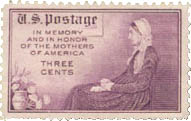Whistler's Mother
|
|
Template:Painting Arrangement in Grey and Black: The Artist's Mother, famous under its colloquial name "Whistler's Mother," is an 1871 oil-on-canvas painting by James McNeill Whistler. The painting is 56.81 x 63.94 in. (144.3 x 162.4 cm), displayed in a frame of Whistler's own design, and is now owned by the Musée d'Orsay in Paris. It occasionally tours worldwide. Although an icon of American art, it rarely appears in the United States, having toured in 1932-1934, appeared at the National Gallery of Art in 1994 and the Detroit Institute of Arts in 2004.
Anna McNeill Whistler posed for the painting while living in London with her son. Several unverifiable stories surround the making of the painting itself; one is that Anna Whistler acted as a replacement for another model who couldn't make the appointment. Another is that Whistler originally envisioned painting the model standing up, but that his mother was too uncomfortable to pose standing for an extended period.
The work was shown at the 104th Exhibition of the Royal Academy of Art in London (1872), but first came within a hair's breadth of rejection by the Academy. This episode worsened the rift between Whistler and the British art world; Arrangement would be the last painting he would submit for the Academy's approval.
The sensibilities of a Victorian era viewing audience would not accept what was ostensibly a portrait being exhibited as a mere "arrangement"; thus the explanatory title "Portrait of the Artist's Mother" was appended. It was from this that the work acquired its popular name. After Thomas Carlyle viewed the painting, he agreed to sit for a similar composition, this one being titled Arrangement in Grey and Black, No. 2. Thus the previous painting became Arrangement in Grey and Black, No. 1 more or less by default.
Whistler would eventually pawn the painting, which was acquired in 1891 by Paris' Musée du Luxembourg. Whistler's works, including this one, had attracted a number of imitators and a number of similarly posed and restricted color palette paintings soon appeared particularly by American expatriate painters. For Whistler, having one of his painting displayed in a major museum helped attract wealthy patron. In December 1884, Whistler wrote:
- "Just think -- to go and look at one's own picture hanging on the walls of Luxembourg -- remembering how it had been treated in England -- to be met everywhere with deference and respect...and to know that all this is...a tremendous slap in the face to the Academy and the rest! Really it is like a dream."
As a proponent of ars gratia artis, Whistler professed to be perplexed and annoyed by the insistence of others upon viewing his work as a "portrait." In his 1890 book, The Gentle Art of Making Enemies, he writes:
- Take the picture of my mother, exhibited at the Royal Academy as an "Arrangement in Grey and Black." Now that is what it is. To me it is interesting as a picture of my mother; but what can or ought the public to care about the identity of the portrait?
Given this outlook, whatever the level of affection Whistler may have felt for his own mother, one finds an even more divergent use of the image in the Victorian era and later, especially in the United States, as an icon for motherhood, affection for parents, and "family values" in general. For example, in 1934 the U.S. Post office issued a stamp engraved with a stylized image of "Whistler's Mother," accompanied by the slogan "In Memory and In Honor of the Mothers of America."
Later the public's interpretation of the symbolism of the painting went even farther afield, and it appeared in a myriad of commercial advertisements and parodies, such as doctored images of the subject watching a television, sometimes accompanied by slogans such as "Whistler's Mother is Off Her Rocker." The artwork played a major part in the 1997 comical farce, Bean.

